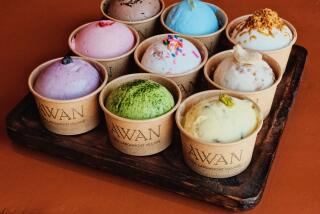First Irradiated Fruit on Market Sells Quickly
- Share via
The first irradiated fresh fruit sold in this country was warmly received by consumers in a North Miami Beach, Fla., produce market recently during an experimental test of the controversial technology’s commercial appeal.
Shoppers at Laurenzo’s Farmers Market squeezed and picked their way through Puerto Rican mangoes that had been exposed to gamma rays before arrival in Florida. The treatment was used to destroy any insect larvae that may have infested the imported fruit.
Earlier this year, the U.S. Food and Drug Administration expanded the theretofore limited applications of irradiation to include fruits and vegetables. The decades-old technology involves exposing foods to controlled doses of Cobalt 60 to destroy bacteria or insect larvae. An identical procedure is also used to sterilize such medical equipment as surgical instruments.
Irradiation opponents are concerned about the long-term effects of consuming foods exposed to gamma rays. A primary objection regards the cellular changes in food brought about by the process. However, FDA officials claim that under the currently approved exposure levels, irradiated products do not pose a health problem.
Corporate Uncertainty
Even so, industry analysts had estimated that it would be several years before any type of irradiated produce reached supermarket shelves because of a facility shortage. There was also corporate uncertainty over whether consumers would actually accept such an alien technology and, if so, would they then purchase such foods. So, the recent experiment in Florida was a pleasant marketing surprise for the nation’s food industry.
Laurenzo’s sold out its 1,500 pound, 150-case shipment of mangoes in about three weeks. A large sign indicating that the fruit was the first irradiated produce item to be sold in the United States was placed above the display. Prominent play was also given to the federally mandated irradiation symbol--a plant surrounded by a broken circle.
The market sold the mangoes for between $1.29 and $1.49 per pound, the most Laurenzo’s has ever received for the tropical fruit.
“The quality is excellent and that is why I bought them,” said David Liff, the store’s produce manager, during a telephone interview. “I always thought that Florida mangoes were the best, but these are the best mangoes I’ve had all year.”
Liff anticipated more complaints about stocking irradiated food than he actually received because of the extended debate over the process’ implementation.
“I have received very little negative response. And if I was shown (research indicating) any aspect of the irradiated mangoes was (potentially harmful) then I would have taken them off the shelf. But no one has shown me anything (convincing),” he said.
Barrage of Media Coverage
Although press exposure wasn’t his motive, Liff and his staff have been besieged by media coverage since he introduced the irradiated product. Local and national publications have inquired about the mango’s reception, as have both U.S. and foreign television networks.
The experience caught the 12-year produce veteran off guard. “I didn’t buy them to get into the newspaper,” he said.
Liff attributes his temporary celebrity to the fact that most other south Florida markets rejected the gamma ray-treated mangoes.
“The fruit was offered to chain stores and a few independent markets and nobody wanted them,” Liff said. “It all started one day when I happened to be asking my produce wholesaler for something different for the holidays and he said, ‘Have I got something unusual for you.’ ”
There is unlikely to be a flood of irradiated produce in coming months despite the success of the Puerto Rican mangoes. The recent shipment was only an experiment, and federal officials have yet to indicate whether other similarly treated commodities will be permitted into this country. The most recent exemption was prompted in part by a poor-quality Florida mango crop this season.
Disclosing Wax Treatment--Increasing numbers of California supermarkets will be displaying signs in produce sections officially disclosing the presence of the waxy coating often found on some fruits and vegetables.
The action was prompted by pressure from area rabbis and a consumer activist who have been critical of food retailers for their failure to inform consumers about the sticky, transparent coverings, according to a supermarket industry trade publication.
The rabbinical opposition stemmed, in part, from concerns over whether the gloss used was made from non-kosher ingredients.
An official of the California Grocers Assn. said that the wax is applied by produce industry packers and shippers to seal the pores of fruits and vegetables in order to prolong shelf life. The substance is prepared from non-animal materials.
The state’s supermarket industry was also encouraged to act because of a federal regulation which requires the disclosure to consumers of additives used on produce that is shipped through international or interstate commerce. Numerous commodities, both waxed and unwaxed, come to California from other states and countries throughout the year.
The signs, available through the grocers organization, read, “A cold application of wax is occasionally used to preserve some agricultural products.”
More to Read
Eat your way across L.A.
Get our weekly Tasting Notes newsletter for reviews, news and more.
You may occasionally receive promotional content from the Los Angeles Times.










